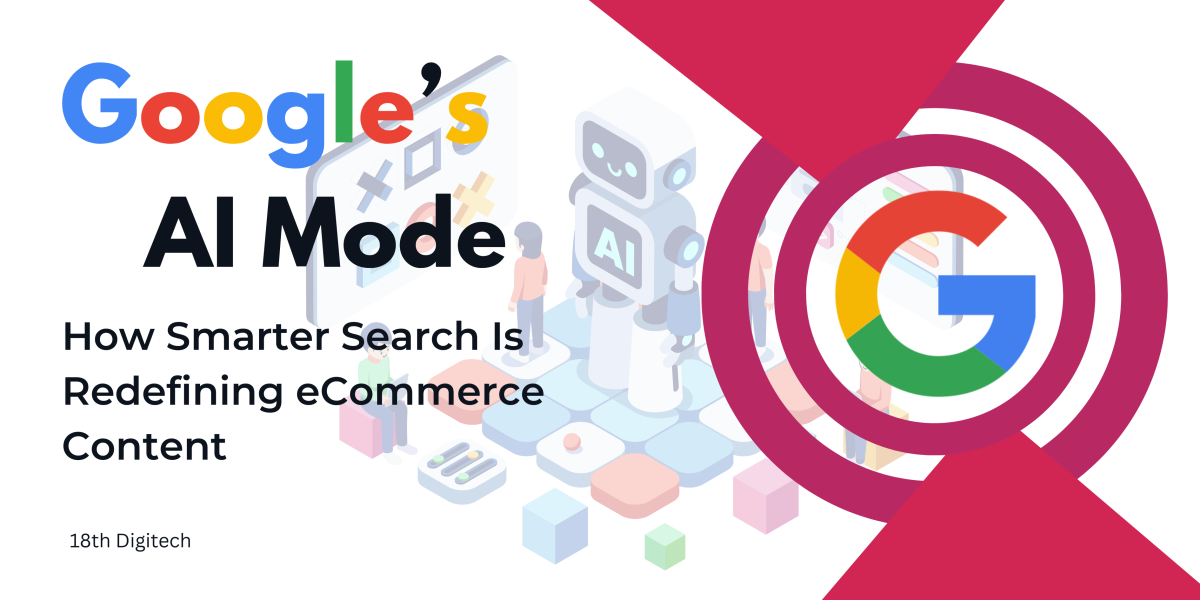Google’s new AI Mode changes how search engines read, connect, and present product information. Here’s why structured, context-rich product data is the key to standing out in AI-powered discovery.
1. A Shift From Search Results to Search Intelligence
Google’s new AI Mode marks one of the biggest transitions in digital search since the introduction of featured snippets. Instead of returning a list of web pages, Google’s AI now creates answers — blending information, insights, and product recommendations directly within the search results.
For retailers, this means a subtle but profound change: your products aren’t just competing for keyword rankings anymore. They’re competing for AI understanding — the ability for Google’s systems to interpret your catalog and include it in generated responses.
Visibility in the age of AI search is no longer about keyword density; it’s about semantic clarity.
2. Why Product Data Has Become the Heart of Visibility
When Google’s AI Mode scans product information, it looks for consistency, structure, and depth.
Thin, incomplete, or inconsistent listings simply don’t provide enough data for the system to trust.
Here’s what matters most now:
- Structured Fields: Complete, machine-readable attributes (size, color, composition, etc.).
- Contextual Clarity: Product descriptions that explain purpose, fit, and benefit.
- Relational Metadata: Schema and tags that connect related items or categories.
- Visual Semantics: Images with alt text that reinforces what’s being shown.
In other words — your content must speak both human and machine language fluently.
3. How Google’s AI Understands What You Sell
Behind AI Mode is a growing web of interconnected data. Every product, category, and brand forms a small piece of this evolving semantic map.
Google’s AI uses this map to infer which products match certain queries — not just by keywords, but by meaning and relationships.
For example:
When someone searches “breathable office shoes for summer,” the AI draws from structured product data to connect “breathable” with “mesh,” “office” with “formal style,” and “summer” with “lightweight materials.”
If your product data doesn’t include those connections, the AI simply won’t find you.
4. Knowledge Graph Meets Agentspace: The Engine Behind AI Mode
To power this new system, Google leans on its Knowledge Graph — a vast network that links entities such as people, brands, and content.
But now, this foundation is being extended through Agentspace, a more dynamic environment where AI can reason about these relationships.
The Knowledge Graph strengthens Agentspace by interlinking three dimensions:
people, content, and interactions.
This triad helps AI generate results that are not only correct but contextually intelligent — results that make sense in the way humans think and shop.
For eCommerce brands, that means your data must be structured so AI can see not just what you sell, but how it connects to buyer intent and broader topics like sustainability, lifestyle, or design.
5. Practical Steps to Make Your Catalog AI-Ready
To prepare for AI-driven visibility, brands should reimagine content workflows.
Here’s a pragmatic roadmap:
- Run a data completeness audit. Check that all key attributes exist and are standardized.
- Write narratives, not just specs. Blend factual accuracy with relatable context.
- Adopt product schema markup. Use Product, Brand, and Offer tags.
- Add image metadata. Name files descriptively and include proper alt text.
- Ensure consistency. Keep tone, vocabulary, and formatting uniform.
- Automate enrichment. Use AI-assisted tools to fill missing data or generate meta information.
- Track generative visibility. Monitor which products appear in AI Mode summaries and adjust content accordingly.
This approach isn’t just about SEO — it’s about making your catalog legible to the AI systems now mediating how discovery happens.
6. From Keywords to Connections
Old SEO rewarded websites that shouted the loudest with keyword density.
Modern AI search rewards those that communicate clearly and consistently.
In this new paradigm:
- Keywords tell search engines what something is.
- Context tells AI why it matters.
Your goal isn’t just to rank — it’s to be understood within the knowledge network that Google’s AI Mode continuously references.
7. The Takeaway: Data Is the New Discovery
AI Mode is not a threat to search visibility — it’s a stress test for data integrity.
Brands with structured, descriptive, and connected product data will rise naturally in AI-curated results. Those relying on outdated, keyword-stuffed descriptions will fade out.
The future of search is not about visibility hacks.
It’s about making your catalog intelligent enough for AI to recommend it with confidence.
Final Thought
Search engines are becoming reasoning engines.
The more your data reflects how real people think, the more likely it is to surface when AI decides what matters most.
Structured product data is no longer a nice-to-have — it’s your ticket to relevance in the AI search era.
Frequently Asked Questions About Google’s AI Mode and Product Data Optimization
1) What exactly is Google’s AI Mode?
AI Mode is Google’s latest evolution in search — a system that uses artificial intelligence to generate complete answers instead of just listing links. It pulls context from multiple sources, including product data, to provide natural, conversational results.
2) How is AI Mode different from traditional SEO?
Traditional SEO relied on ranking signals like backlinks, titles, and keyword frequency. AI Mode, on the other hand, focuses on understanding meaning. It prioritizes structured data, context, and relationships between products, brands, and topics.
3) Why is structured data so critical now?
AI systems interpret structured data the way humans use grammar — it helps them understand what your products are and how they relate to other things. The richer your data (attributes, schema, relationships), the better AI can represent your products accurately.
4) What is the connection between Google’s Knowledge Graph and Agentspace?
The Knowledge Graph is Google’s database of entities and their relationships — think of it as a web of meaning. Agentspace builds on that by letting AI reason across this web, linking people, content, and interactions to deliver more personalized, relevant results.
5) How can eCommerce brands prepare for AI-driven search?
Brands should focus on clean, complete product data. Fill in all attributes, adopt product schema markup, write descriptive copy, and maintain consistency across the catalog. The goal is to make your data readable and trustworthy for AI.
6) Will AI Mode make traditional SEO obsolete?
Not at all — it expands it. Keywords and meta tags still matter, but they now work in tandem with structured data, brand consistency, and semantic clarity. AI Mode rewards content that’s both human-friendly and machine-interpretable.
7) Does AI Mode affect small and large retailers differently?
Yes. Large retailers with structured catalogs may have an advantage, but smaller brands can outperform them by publishing richer narratives, detailed attributes, and better metadata. AI systems value clarity over size.
8) What tools or methods can help improve data quality?
Automation and AI-based enrichment tools can assist with filling missing fields, generating meta content, and maintaining tone consistency. But human oversight remains essential to ensure brand authenticity and factual accuracy.
How to Make Your Product Catalog AI-Search Ready
- Audit your existing data. Identify gaps, inconsistencies, and outdated descriptions.
- Standardize attributes. Use uniform values for fields like size, color, and material.
- Adopt structured markup. Add Product, Brand, and Offer schema for clarity.
- Write purpose-driven descriptions. Go beyond features—describe use cases and value.
- Optimize images. Use descriptive filenames, captions, and alt text.
- Add relationships. Link related products, variants, or accessories through tags or schema.
- Test visibility. Search your own products in AI summaries and adjust based on results.
This process helps ensure your catalog isn’t just searchable — it’s understandable to AI systems shaping the next phase of online discovery.










 About 18th Digitech
About 18th Digitech Awards and Credentials
Awards and Credentials Our Partners
Our Partners

